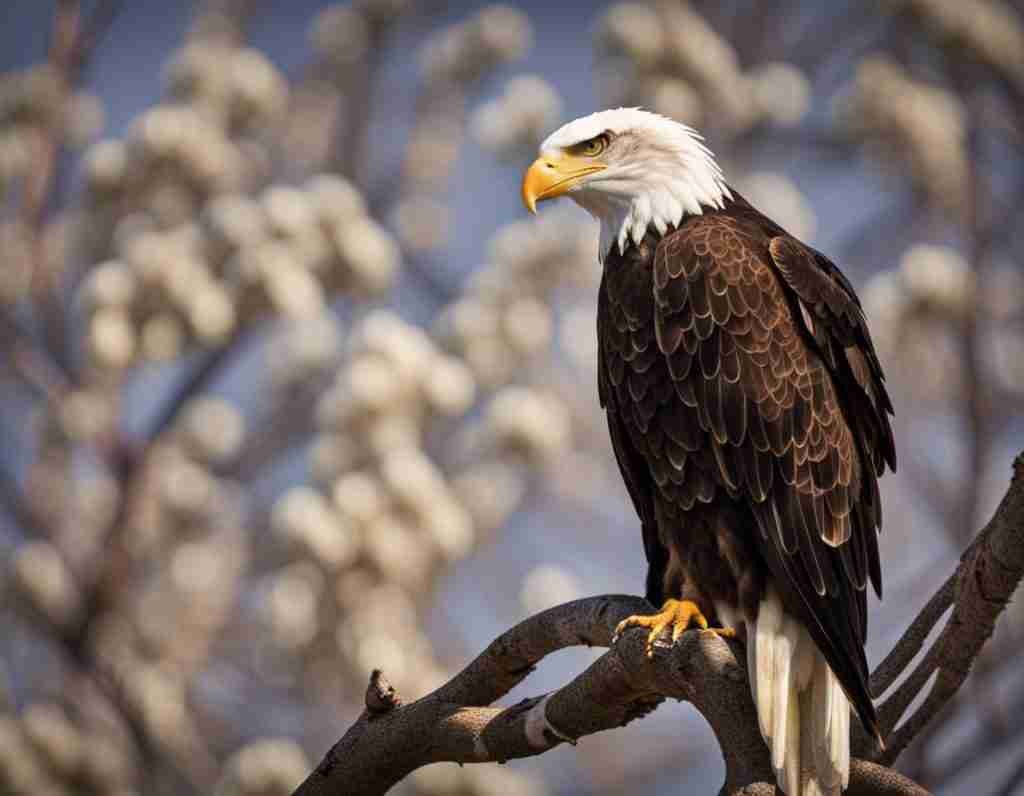Imagine taking a leisurely stroll along the coastline of Florida, with the sun shining brightly above and the gentle sound of waves crashing against the shore. As you breathe in the salty ocean air, you may not realize that you are in the midst of witnessing one of nature’s greatest comebacks.
The population of bald eagles in Florida has been steadily increasing over the years, a testament to the efforts of conservationists and the resilience of these magnificent birds. In this article, we will explore the remarkable rise in Florida’s bald eagle population and the impact it has on the state’s diverse ecosystem

Historical Background of Bald Eagles in Florida
Decline and Near Extinction of Bald Eagles in Florida
The bald eagle, a majestic bird of prey and a symbol of American strength and independence, has had a tumultuous history in the state of Florida. In the mid-20th century, the population of bald eagles in Florida suffered a severe decline, primarily due to the widespread use of pesticides like DDT. These chemicals caused thinning of eggshells, resulting in reduced hatching success and raising concerns about the long-term survivability of the species.
By the late 1960s, the bald eagle population in Florida had plummeted to dangerously low levels. The once-thriving population had dwindled to just a few dozen nesting pairs, putting the species on the brink of extinction. It was a stark reminder of the detrimental impact humans can have on the natural world.
Conservation Efforts and Their Impact on Bald Eagle Populations
Recognizing the urgent need to protect and restore the bald eagle population, conservation efforts were undertaken in Florida. These efforts focused on addressing the primary threats to the species and creating a conducive environment for their recovery.
One of the key conservation strategies implemented was the establishment of protected areas and the preservation of vital bald eagle habitats. These measures helped ensure the availability of suitable breeding grounds and nesting sites. Additionally, habitat restoration projects aimed to rejuvenate degraded areas and provide the necessary resources for the eagles’ survival.
Another crucial aspect of the conservation efforts was the reduction of pollutants and contaminants in the environment. Strict regulations and enforcement played a significant role in curbing the use of harmful pesticides and chemicals, allowing the bald eagle population to rebound. The ban on DDT, in particular, proved instrumental in mitigating the detrimental effects on eagle eggs and subsequent hatching success.
Additionally, successful breeding and nesting programs were essential in rejuvenating the bald eagle population in Florida. These programs involved monitoring nesting sites, protecting eggs and chicks from predation, and providing supplementary food resources during critical periods. Through these initiatives, the survival and reproductive rates of bald eagles significantly increased, contributing to their overall population growth.
Furthermore, steps were taken to address the availability of prey and food sources for bald eagles. Conservation efforts targeted the preservation of natural habitats for fish and wildlife, ensuring a sustained supply of food for the eagles. These measures helped maintain a stable ecosystem and provide the necessary resources for the thriving bald eagle population.
Lastly, the regulation and control of harmful activities near nesting sites played a pivotal role in protecting the eagles and their habitats. Limiting disturbances during the breeding season helped minimize stress and increase breeding success. With strict enforcement, the eagles’ nesting sites were safeguarded from human encroachment and potential disturbances, ensuring the survival and growth of their populations.
Factors Contributing to the Rising Population of Bald Eagles in Florida
Habitat Protection and Restoration Efforts
The rising population of bald eagles in Florida can be attributed to several key factors. Foremost among these is the significant progress made in habitat protection and restoration efforts. By designating protected areas and implementing conservation measures, crucial habitats for the eagles have been preserved and enhanced. The establishment of wildlife refuges and national parks has provided secure breeding grounds and nesting sites for the eagles, ensuring the long-term viability of their populations.
Additionally, habitat restoration projects have been successful in rejuvenating degraded areas and creating suitable environments for the eagles to thrive. By restoring wetlands, forests, and waterways, these projects have not only benefited bald eagles but also enhanced the overall biodiversity and ecological health of Florida’s ecosystems.





Reduction in Pollutants and Contaminants in the Environment
One of the significant contributors to the rise in the bald eagle population in Florida has been the reduction of pollutants and contaminants in the environment. Strict regulations and successful advocacy efforts have led to the ban or significant reduction in the use of harmful pesticides and chemicals. By curbing the release of these substances into the environment, the health and reproductive success of the eagles have improved, leading to population growth.
Successful Breeding and Nesting Programs
Successful breeding and nesting programs have been instrumental in driving the population growth of bald eagles in Florida. Through careful monitoring, protection, and management of nesting sites, these programs have significantly increased the survival and reproduction rates of the eagles. Additionally, providing supplementary food resources during critical periods has further enhanced breeding success, ensuring the persistence of the species.
Increased Availability of Prey and Food Sources
Conservation efforts targeting the preservation of natural habitats for fish and wildlife have contributed to the increased availability of prey and food sources for bald eagles in Florida. By protecting and restoring these habitats, the populations of prey species such as fish, waterfowl, and small mammals have also thrived. This abundance of food resources has provided the necessary sustenance for the eagles, allowing them to flourish and expand their populations.
Regulation and Control of Harmful Activities near Nesting Sites
The regulation and control of harmful activities near nesting sites have played a crucial role in the rising population of bald eagles in Florida. By implementing strict enforcement and education programs, human disturbances and nest destruction have been significantly reduced. Keeping nesting sites free from harmful activities has provided a safe and undisturbed environment for the eagles to breed successfully and raise their young.

Impacts of the Rising Bald Eagle Population on the Ecosystem
Influence on the Fish and Wildlife Population
The rising population of bald eagles in Florida has had a noticeable influence on the fish and wildlife population. As apex predators, eagles help maintain a balance in the ecosystem by regulating the populations of their prey species. By preying on fish, waterfowl, and small mammals, eagles keep their numbers in check, preventing overpopulation and supporting healthy ecosystems.
Additionally, the scavenging nature of bald eagles contributes to the overall health of the ecosystem. Eagles feed on carrion, removing dead and decaying organisms from the environment and preventing the spread of disease. Their presence helps maintain the cleanliness and stability of the ecosystem, benefiting other wildlife species and human communities.
Indication of Environmental Health and Stability
The rising population of bald eagles in Florida serves as a significant indication of environmental health and stability. As sensitive indicators of ecosystem quality, the presence of thriving eagle populations suggests the successful management and safeguarding of their habitats. The recovery of this iconic species reflects the overall health and resilience of Florida’s natural systems, symbolizing the progress made in conservation efforts and ensuring a promising future for biodiversity.

Economic and Ecotourism Benefits of Bald Eagle Population Growth
Increased Tourism and Revenue
The growing population of bald eagles in Florida has resulted in increased tourism and revenue. Wildlife enthusiasts, birdwatchers, and nature lovers from around the world are drawn to witness the majestic sight of these iconic birds in their natural habitats. The influx of tourists to areas known for their eagle populations has led to an expansion of ecotourism opportunities, creating economic benefits for local communities.
Visitors to Florida’s bald eagle hotspots spend money on accommodations, transportation, food, and various recreational activities, contributing to the local economy. Additionally, guided tours, photography workshops, and other eco-focused enterprises have emerged, providing employment opportunities and generating revenue for tour operators and local businesses.
Job Creation and Local Economic Growth
The rising populations of bald eagles in Florida have not only offered economic benefits through tourism but also created job opportunities and fostered local economic growth. As ecotourism activities increase, there is a demand for skilled guides, educators, biologists, and other professionals specializing in wildlife conservation. These jobs not only provide direct employment but also support related industries such as hospitality, food services, and transportation.
Furthermore, successful conservation efforts and the resulting increase in wildlife populations contribute to the overall attractiveness of Florida as a place to live and work. This can lead to population growth and increased demand for housing, infrastructure, and services, stimulating local economies and promoting sustainable development.

Challenges and Threats to the Bald Eagle Population in Florida
Habitat Loss and Fragmentation
Despite the success in recovering the population of bald eagles in Florida, several challenges and threats persist. One of the primary concerns is habitat loss and fragmentation. As human populations continue to expand, the conversion of natural habitats for residential, commercial, and agricultural purposes poses a significant threat to the eagles’ breeding and nesting sites. The loss and fragmentation of suitable habitats limit the available space for the eagles, potentially hindering their population growth and long-term survival.
Human Disturbance and Nest Destruction
Intentional or unintentional human disturbance remains a significant threat to the bald eagle population in Florida. Activities such as approaching nesting sites too closely, disturbing breeding pairs or chicks, and vandalizing nests can have severe consequences. These disturbances can lead to nest abandonment, stress, and reduced reproductive success, ultimately impacting the population size and growth rate.
Climate Change and Sea Level Rise
The changing climate and sea level rise present additional challenges for the bald eagle population in Florida. Rising temperatures, altered weather patterns, and more frequent extreme weather events can disrupt the eagles’ breeding and foraging patterns. Additionally, sea-level rise can impact coastal nesting sites, potentially leading to habitat loss and population declines. The long-term effects of climate change on the eagles’ habitat and food availability require attention and proactive measures to ensure their survival.
Disease and Parasite Outbreaks
Disease and parasite outbreaks pose a threat to the health and well-being of the bald eagle population in Florida. Avian influenza, West Nile virus, and other infectious diseases can spread among the eagles, leading to sickness, mortality, and reduced reproductive success. Additionally, external parasites such as ticks and mites can negatively affect the eagles’ overall health and compromise their ability to thrive. Vigilant monitoring, research, and disease prevention measures are essential to mitigate these risks and protect the population.

Conservation and Management Strategies for the Future
Continued Habitat Preservation and Restoration
To ensure the long-term viability of the bald eagle population in Florida, continued habitat preservation and restoration efforts are paramount. Protecting existing habitats and creating new protected areas can provide the eagles with sufficient space and resources to sustain their populations. Collaborative initiatives between government agencies, conservation organizations, and local communities are crucial in identifying and safeguarding essential eagle habitats.
Furthermore, restoring degraded habitats, such as wetlands and forests, can contribute to the health and diversity of ecosystems, benefiting not only the eagles but also other wildlife species. By implementing sustainable land-use practices and minimizing habitat fragmentation, the groundwork can be laid for the continued success and growth of the bald eagle population.
Public Awareness and Education Programs
Public awareness and education programs play a vital role in garnering support and participation in bald eagle conservation efforts. By raising awareness about the species’ importance to the ecosystem and its cultural significance, these programs foster a sense of responsibility and stewardship among the general public. Educating individuals about the threats facing bald eagles and the actions they can take to contribute to their conservation promotes a more sustainable coexistence with these majestic birds.
Regulation and Enforcement of Nest Protection
The regulation and enforcement of nest protection measures are crucial for safeguarding the bald eagle population in Florida. Strict enforcement of laws and regulations against activities that disturb or harm the eagles and their nests is necessary. Regular monitoring and surveillance of nesting sites can help identify potential threats and allow for timely intervention. Removing nests and eggs from illegal trade and ensuring their protection in situ are essential aspects of the conservation and management strategy.
Integration of Climate Change Adaptation Measures
Given the potential impacts of climate change on the bald eagle population, the integration of adaptation measures is crucial. Proactive monitoring and research can help identify changes in weather patterns, sea-level rise, and other climate-related factors. Strategies such as establishing alternative nesting sites in higher elevations or protected inland areas can mitigate the potential impacts of habitat loss due to rising sea levels. By incorporating climate change considerations into conservation planning and management, the bald eagle population can be more resilient and better equipped to face future challenges.
Collaboration and Partnerships with Stakeholders
Collaboration and partnerships with various stakeholders are key to the success of bald eagle conservation and management in Florida. Government agencies, non-profit organizations, local communities, and private landowners need to work together to implement effective conservation strategies. Sharing expertise, resources, and best practices can reinforce conservation efforts and help address the complex challenges faced by the bald eagle population. By fostering collaborations and partnerships, a unified approach can be taken towards the long-term sustainability of this iconic species.
In conclusion, the rising population of bald eagles in Florida is a remarkable conservation success story. Efforts to protect habitats, reduce pollutants, implement breeding programs, and regulate harmful activities have contributed to their recovery and resurgence. The thriving eagle populations not only benefit the ecosystem but also bring economic and ecotourism advantages. However, continued conservation efforts are necessary to address challenges such as habitat loss, human disturbance, climate change, and disease outbreaks. By implementing strategies that focus on habitat preservation, public awareness, nest protection, climate change adaptation, and collaboration, the future of the bald eagle population in Florida can be secured for generations to come.




